Summary
Summary from the Chair of the Committee

The work of the President’s Advisory Committee centered on the four guiding principles of the University’s Division of Diversity, Equity and Inclusion:
- Increasing the number of, retaining and graduating historically underrepresented students.
- Increasing and retaining the number of diverse faculty and staff.
- Creating a more welcoming and inclusive campus community in which all members thrive.
- Providing opportunities for faculty, staff and students to develop cultural competencies.
Success with these institutional goals requires an increased knowledge of diversity, equity and inclusion (DEI) for all members of the campus community, infusion of the principles and best practices of DEI into all aspects of the University’s operations and measures of assessment, and accountability to track institutional progress.
The set of recommendations in this report were developed as a result of:
- Review and study of institutional data related to the DEI goals.
- Presentations by higher education diversity subject matter experts.
- A review of the literature and the most promising practices of diversity in higher education.
- Acknowledgement of the dramatic demographic shifts occurring in this country and their implication for higher education.
- Review of the expressed concerns of many members and groups within The University of Alabama community, including Faculty Senate, Black Faculty and Staff Association, African American tenured faculty, a host of academic units, Student Government Association, and a racially diverse range of student leaders.
- Acknowledgement of the University’s role and responsibility in addressing the ongoing national crisis regarding the impact of systemic racism on the lives of all American citizens.
- Acknowledgement of our institutional responsibility to prepare all The University of Alabama students through curricular and co-curricular experiences to operate effectively and efficiently in an increasingly global and diverse society.
- Acknowledgement that building an inclusive campus is a shared responsibility for all members of our academic community—our faculty, staff and students.
It is strongly believed by this committee that the implementation of these recommendations by the identified areas will move the campus to the next level of inclusive excellence; it is our Path Forward. As defined by the Association of American Colleges and Universities, “inclusive excellence is the guiding principle for access, student success, and high-quality learning designed to help colleges and universities integrate diversity, equity, and educational quality efforts into their missions and institutional operations.”
My deepest gratitude goes to the members of the committee for their ongoing commitment and work with this project. I sincerely value their time, insights and dedication to bringing this document to fruition.
G. Christine Taylor, PhD
Vice President and Associate Provost
Division of Diversity, Equity and Inclusion
The University of Alabama
Introduction
We have made progress on this campus in many ways, but we still have much we can and must do. I look forward to the work of this committee and to the impact it will make on the future of this great University.” Stuart R. Bell, PhD, President
Presidential Advisory Committee to Support Campus Diversity Goals

On Oct. 18, 2019, University of Alabama President Stuart R. Bell announced the establishment of a presidential advisory committee to support ongoing coordination and expansion of efforts related to diversity, equity and inclusion at The University of Alabama.
The Charge
The committee will further advance specific plans and strategies, and propose solutions with measurable objectives, to accomplish the third goal of UA’s strategic plan. The third goal aims to enrich the campus learning and work environments by providing an accepting, inclusive community that attracts and supports a diverse faculty, staff and student body.
Strategic Measures: Goal 3
Minority Student Retention Rates
Minority Student Graduation Rates
Committee Members
Dr. G. Christine Taylor
Committee Chair
Vice President and Associate Provost for Diversity, Equity and Inclusion
Robert Baxter
2019-2021 Professional Staff Assembly President
Dr. André Denham
2019-2020 Black Faculty and Staff Association President
2020-2021 Black Faculty and Staff Association Vice President
Dr. Rona Donahoe
2019-2021 Faculty Senate President
Matt Fajack
Vice President for Finance and Operations
Demarcus Joiner
2019-2020 SGA Vice President for Diversity, Equity and Inclusion
2020-2021 Student Government Association President
Dr. Stacy Jones
Associate Dean of Students/Interim Dean of Students
Layne Lightfoot
Honors College Student Representative
Dr. LeNá McDonald
Project Coordinator in the President’s Office
Angel Narvaez-Lugo
2019-2020 Office, Clerical & Technical Staff Assembly President
Chad Tindol
Chief Administrative Officer
Dr. Kevin Whitaker
Executive Vice President and Provost
Harrison Adams
2019-2020 Student Government Association President
Diversity, Equity and Inclusion Briefings/Readings
The committee engaged in activities to broaden their knowledge base of diversity, equity and inclusion in higher education and diversity, equity and inclusion issues specific to The University of Alabama. The committee’s work was informed through various sources including briefings; diversity, equity and inclusion readings; campus feedback sessions; campus correspondence; constituent feedback; institutional data; and higher education best practices from the National Association of Diversity Officers in Higher Education (NADOHE), Association of American Colleges and Universities (AAC&U), and the American Council of Education (ACE). The briefings and readings are as follows:
Presentations

Diversity, Equity and Inclusion in Higher Education
Dr. G. Christine Taylor
Vice President/Associate Provost Diversity, Equity and Inclusion
The University of Alabama

Diversity and University of Alabama Admissions
Dr. Matthew McLendon
Associate Vice President and Executive Director Enrollment Management
The University of Alabama

Diversity and Undergraduate Enrollment, Matriculation and Completion
Diversity and Faculty/Diversity and Staff
Lorne Kuffel
Executive Director
Institutional Research and Assessment
The University of Alabama
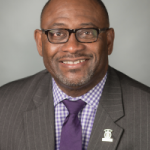
Engaging with Diverse Alumni
Tyronne Carr
Director, Alumni Diversity Initiatives and Executive Director
The Interlink Alliance
Ohio University

Recruiting Diverse Faculty and Review of Future Faculty Program
Dr. Menah Pratt-Clarke
Vice President
Strategic Affairs and Vice Provost Inclusion and Diversity
Virginia Tech

Recruiting Diverse Staff
Erik Smetana
Executive Director, Compensation
and Talent, Office of Human Resources Vanderbilt University
Regional Director, Southeastern
Higher Education Recruitment Consortium

Building an Inclusive Campus Community
Dr. Kevin McDonald
Vice President
Diversity, Equity and Inclusion University of Virginia
Former Chief Diversity Officer
Vice Chancellor Inclusion, Diversity and Equity
University of Missouri System and the University of Missouri – Columbia
Readings
Letters and Responses for Committee Review
Concerned Student Letters
The Concerned Students of the University of Alabama Sept. 11 and 16, 2019
Response from President Bell dated Sept. 27, 2019
SGA Resolutions passed on Sept. 12, 2019
Affirming The University of Alabama’s Commitment to Protecting the Freedom of Speech and Academic Freedom for Students, Faculty, and Staff
Response from President Bell dated Sept. 27, 2019
Black Faculty and Staff Association Letter First letter received Sept. 12, 2019
Response from President Bell dated Sept. 27, 2019
Gender and Race Studies Graduate Students Sept. 16, 2019
Response from Vice Presidents Taylor and Cramer
Faculty Senate Letter
First letter received Sept. 17, 2019
Response from President Bell dated Sept. 27, 2019
Professional Staff Assembly Letter First letter received Sept. 19, 2019
Response from President Bell dated Sept. 27, 2019
New College Faculty Letter
First letter received Sept. 24, 2019
Response from President Bell dated Sept. 27, 2019
Department of English Received Oct. 1, 2019
Response from President Bell Oct. 10, 2019
United Campus Workers of Alabama Received Oct. 3, 2019
Law School Students and Alumni Letter Received Oct. 7, 2019
Response from President’s Office dated Oct. 8, 2019
Department of Educational Leadership, Policy and Technology Studies
Received Oct. 9, 2019
Response from President Bell dated Oct. 14, 2019
Daniel J. Levine, Aaron Aronov Chair in Judiac Studies, Departments of Political Science and Religious Studies
Received Oct. 10, 2019
Response from President’s Office dated Oct. 17, 2019
LGBTQ Alumni Association Received Oct. 16, 2019
Response from President’s Office dated Oct. 16, 2019
Select Readings/Student Group Feedback
Student Engagement in Higher Education
Theoretical Perspectives and Practical Approaches for Diverse Populations
Edited by Stephen John Quaye and Shaun R. Harper
Chapter 1: Making Engagement Equitable for Students in U.S. Higher Education Shaun R. Harper and Stephen John Quaye
Chapter 2: Engaging Students of Color Stephen John Quaye, Kimberly A. Griffin and Samuel D. Museus
Chapter 8: Engaging Lesbian, Gay, and Bisexual Students on College Campuses, Dafina-Lazarus Stewart and Mary F. Howard-Hamilton
Chapter 15: Engaging Low-Income Students Adrianna J. Kazar, MaryBeth Walpole, Laura W. Perna
Data Collected from A Path Forward Campus Event Issues/concerns, examples, suggestions and
“We could be a more welcoming community if we…”
Started…
Stopped…
Continued…
Other…
RECOMMENDATIONS
Recruiting, Retaining and Graduating More Diverse Students
The larger committee divided into four specific focus areas which align with the four over-arching goals of the Division of Diversity, Equity and Inclusion. An additional subcommittee provided recommendations for the institutional infrastructure required to effectively implement the recommendations of the committee as a whole. In keeping with the president’s request of immediate, short-term and long-term recommendations the advisory committee assigned each recommendation a timeline designation of A, B or C as follows:
A = 6-12 months B = 1-3 years C = 3-5 years
Under each section, the report identifies the primary areas responsible for implementing the recommendations.
RECRUITMENT
Implementation: Enrollment Management/Division of Diversity, Equity and Inclusion/Division of Student Life/Graduate School

- Establish a recruitment team comprised of representatives of Diversity, Equity and Inclusion and Enrollment Management. This team will be charged with developing and implementing a comprehensive strategy to recruit, admit and support an undergraduate population that reflects the racial and economic demographics of the State of Alabama by employing high-impact diversity recruitment practices such as, but not limited to, the following. B
Implementation Strategies
Undergraduate
- Increase the number of diversity-focused campus visitation programs such as OUR BAMA. A
- Develop outreach strategies which increase the visitation of more prospective diverse students and parents to the campus. A
- Develop culturally framed recruiting and yield events for diverse students by creating a sustained relationship among Enrollment Management; Diversity, Equity and Inclusion; and University of Alabama alumni groups, such as the Black Alumni Association. A
- Develop a “return-to-high-school program” which supports the return of trained diverse student ambassadors to go back to their high schools to discuss their University of Alabama experience. B
- Enhance the production of diversity marketing materials (print and digital) that communicate the multifaceted experiences of diverse students at The University of Alabama. A
- Host college-preparation workshops for the families of diverse 7th-9th graders focusing on 1) the importance of the college experience, 2) academic college preparation, 3) financing college, and 4) parents’ role in preparing for the college experience. B
- Ensure representation of diverse members of The University of Alabama community at all recruiting events by increasing the participation of diverse faculty, staff, students and alumni. A
Graduate
- Develop and sustain a strong pipeline program between Minority Serving Institutions, also known as MSIs, and The University of Alabama to cultivate relationships and to increase the diversity of graduate student applicants. B
- Build a stronger pipeline of students working collaboratively with the faculty between The University of Alabama and the 151 McNair Scholars Programs located throughout the country. The McNair Scholars programs prepare undergraduate students for doctoral studies through involvement in research and other scholarly activities with the ultimate goal of increasing graduate degree attainment by students. B
SCHOLARSHIPS
Implementation: Enrollment Management
- Increase the undergraduate scholarship funding, graduate assistantships and programmatic initiatives to provide greater support for low-income, first-generation and diverse student populations. B
- Develop and implement a scholarship program to increase socioeconomic diversity of the undergraduate population and improve access for underserved communities within the state of Alabama. This program design should acknowledge the barriers which often impede the access and success of underserved students to higher education. B
PERSISTENCE AND GRADUATION
Implementation: Office for Academic Affairs/Division of Diversity, Equity and Inclusion/Division of Student Life/Office of Institutional Research and Assessment/Graduate School
 Undergraduate
Undergraduate
- Create a task force comprised of representatives from Student Life, DEI, Faculty Senate, Institutional Research and Academic Affairs to develop strategies to achieve equitable student outcomes with respect to the six-year undergraduate student graduation rates, a key DEI institutional metric. The task force should identify factors which contribute to the current variance that exists with this metric and propose solutions. A
- Recommended areas of review include:
- Assess the effectiveness of all current programs related to mentoring, tutoring and academic coaching for students who have less than a 2.5 GPA. B
- Examine the efficacy of an early alert system for all students to ensure they are engaged related to academic performance utilizing data such as mid-semester and end-of-semester grades in the first and second year of matriculation. B
- Expand opportunities for mentoring of historically underrepresented students with program models such as the BRIDGE and Lucy’s Legacy programs implemented in 2019 to support men and women of color, respectively. B
- Increase underrepresented student participation in the high-impact educational practices on the UA campus, such as Study Abroad, undergraduate research, first-year experiences, internships, community-based learning and common intellectual experiences. B
Graduate
- Expand the capacity of the Tide Together graduate student mentoring program which provides professional development, academic development, and social support to first-generation students, women in STEM, and underrepresented students (LGBTQIA, veterans, non-traditional). The program is currently limited to 30 graduate students. B
ENHANCED CAMPUS LIVING AND LEARNING EXPERIENCE
Implementation: Division of Student Life/Division of Diversity, Equity and Inclusion
- Infuse institutional expectations for the contributions of all students to build a more inclusive and welcoming University of Alabama community within the undergraduate student orientation (Bama Bound) and the graduate school student orientation. A
- Expand and enhance Week of Welcome events to include more intentional and targeted programming for diverse student communities beyond the current Black Faculty and Staff Association welcome event, ONYX, and I Am Alabama reception. B
- Embed orientation seminars designed to provide support to historically underrepresented students within the overall campus orientation programs at the undergraduate and graduate levels. B
- Build intentional initiatives to increase the campus engagement of diverse students with diverse faculty/staff, diverse affinity groups and diverse alumni organizations. A
- Work with the established general education task force to include diversity, equity and inclusion in the University’s general education requirement. B
- Present a series of co-curricular experiences to enhance students’ understanding of diversity, equity and inclusion and the historical context of diverse communities. B
- Update the bias protocols for current and incoming students and review our Student Code of Conduct to enhance our ability to reinforce the institutional commitment to Goal #3 of the strategic plan and the Capstone Creed. A
- Implement a restorative justice program as an additional education tool for students who engage in bias events or other campus disruptive behavior. Restorative justice empowers students to resolve conflicts on their own and in small groups. B
- Create a student ambassador program to provide peer education about the major concepts of diversity, equity and inclusion. B
- In support of building a more inclusive campus community, the UA Student Government Association will institutionalize recent programs that support diversity, equity and inclusion such as the Diversity Certificate Program. A
- Establish a more robust documentation of the diverse student experience at Alabama through videos, photographic images, web presence and print materials. A
- University leadership should conduct scheduled meetings and/or town halls with diverse members of the campus community and those concerned with social justice to increase communications and exchange of ideas. A
Recruiting and Retaining More Diverse Faculty and Staff
Implementation: Office for Academic Affairs/Division of Diversity, Equity and Inclusion/Human Resources/Faculty Senate

- Develop and implement a campuswide inclusive hiring practice workshop for faculty and staff hiring committees to support the goal of increasing the diversity of staff and tenure-track faculty. The workshop would include training on recognizing implicit bias, building a diverse candidate pool and incorporating institutional cultural responsiveness in the search process. A
- Institute appropriate checks and balances and certification for each faculty and staff search process to ensure all known inclusive hiring best-practice techniques are employed. (Examples: requesting availability pool data from the Office of Equal Opportunity and Affirmative Action, advertising, developing the pool, non-bias review applications) B
- Prepare an Internal Labor Market (ILM) analysis for each college and unit of the University. An ILM analysis is a tool to provide a comprehensive understanding of the hiring, promotion and retention patterns of all employees within a unit. This kind of analysis can provide a specific understanding of the labor movement of women and diverse faculty and staff members. (See Appendix 1) B
- Conduct exit surveys with all employees departing from the institution as standard operating procedures. Exit interviews can be used to gather more data to guide the design and implementation of hiring initiatives and to increase institutional inclusivity and organizational productivity. A
- Maximize utilization of membership organizations such as Higher Education Recruiting Consortium (HERC) and SREB during the recruiting process. These organizations specialize in advancing inclusive excellence in the higher education workforce. A
- Enhance recruiting and onboarding for new diverse faculty and staff hires by providing them access to campus and community diversity resources and information regarding university affinity groups. A
- Identify a point person for all units who will provide unit oversight and assessment of the plans, programs and initiatives that enhance diversity, equity and inclusion. A
- Provide professional development and leadership advancement opportunities to promote an equitable presence of historically underrepresented faculty and staff in university administration. B
- Intensify efforts to recruit, support and retain faculty of color. The University of Alabama should form a task force comprised of tenured faculty members to conduct a comprehensive analysis of how recruitment, retention, professional development and collegial experiences of University of Alabama underrepresented minority faculty are affected by race and gender. This analysis will serve as the basis for actionable and measurable recommendations on how to improve the recruiting, hiring, and retention of underrepresented minority faculty. (See Appendix 2) A
- Embed DEI competencies into the employee annual performance review process to measure inclusive behavior by employees, ensure accountability of Goal #3 of the strategic plan, track employee growth overtime, and recognize the contributions of outstanding employees. (See Appendix 3) B
FACULTY-SPECIFIC INITIATIVES
- Conduct, with the leadership of the provost, a review of the tenure and promotion process to re-value the service performed by faculty in the interest of advancing racial equality. The review would take into account such work as mentoring of underrepresented students or performing service to underserved communities. Units should ensure that these highly valued contributions of the tenure and promotion process do not prohibit faculty from advancing in rank in a timely manner. A
- Create college and universitywide learning opportunities for junior faculty members to help bring clarity to the tenure and promotion process. Proposed topics include: preparing for mid-tenure review, tenure and promotion dossier preparation, increasing writing productivity, forming research collaboratives, and work/life balance. A
- Enhance engagement with diverse faculty pipeline programs such as the Academic Common Market of the Southern Regional Education Board (SREB) and UNCF/Mellon. (See glossary) B
Creating a More Welcoming Campus Community
Implementation: Division of Diversity, Equity and Inclusion/Office for Academic Affairs/Human Resources/Faculty Senate/Professional Staff Assembly/Office, Clerical and Technical Staff Assembly

- Continue to affirm Academic Freedom, which is covered by the Faculty Handbook, Chapter 3, Section I. Details are given by the cited AAUP statement link: https://www.aaup.org/report/1940-statement-principles-academic-freedom-and-tenure. A
- Provide institutional support for new and existing affinity groups to be facilitated jointly by the Division for Diversity, Equity and Inclusion, the Faculty Senate’s DEI Committee and other employee organizations. Significant progress was made during the 2019-2020 academic year. Existing affinity groups include the Black Faculty and Staff Association, Capstone Alliance, Latinx Faculty and Staff Association, and Jewish Faculty and Staff Association. A
- Expand the opportunity for campus visitors to take the Hallowed Grounds: Race, Slavery and The University of Alabama walking tour of campus. A
- Establish a Presidential Commission on Race, Slavery and Civil Rights at The University of Alabama and complete the process for joining the Universities Studying Slavery Consortium. A
- Institutionalize the Martin Luther King Jr. Campus Commemorative Committee by sending the committee’s duties and composition description to the Committee on University Committees for approval as a new Section I University Standing Committee. A
- Rename and/or add contextualized signage to several campus buildings. A special committee of the Board of Trustees is investigating this issue across the System. Recommendations for appropriate signage and text for contextualizing campus buildings should come from the UA Commission on Race, Slavery and Civil Rights. A comprehensive list of UA buildings named for individuals with problematic histories or used in support of the institution of slavery, was compiled by Dr. Hilary Green and Dr. Erik Peterson at UA. B
- Review existing social media policies for faculty, staff and students with a goal of developing more definitive guidance on its social media guidelines. B
- Develop online resources to assist with the on-boarding and acclimation of employees to the University and community. These resources would be an important component of a welcoming campus environment. B
- Establish a Presidential Commission on Truth, Racial Healing & Reconciliation. This recommendation is driven by the work that the Association of American Colleges & Universities has been doing. UA has never fully gone through the process of publicly dealing with its historical ties to slavery. The Commission would lead the campus through the process of revealing the past to enable racial healing and reconciliation. B
- Initiate DEI Awards for faculty, staff and students. The three awards, one in each recipient category (faculty, staff, students), should be presented annually to members of the UA campus community who exemplify the highest standards of leadership, service and dedication to promoting diversity, equity and inclusion. The DEI Awards would be University Premier Awards, joining the Sullivan, Bloom, Ramsey, Mayer, Bonner and Randall Awards, with nominations to be solicited, and recipients recommended, by the Awards Committee. Awardees would be celebrated at the Premier Awards Banquet held in the Spring semester and given special recognition at the Spring Campus Assembly and the Tapping on the Mound Ceremony during Honors Week. In addition, we recommend that opportunities to endow and name a fund to support the DEI Awards should be explored by the Office for University Advancement. A
- Establish a second on-campus childcare center to support work-life balance for the campus community and recruitment and retention of underrepresented faculty, staff and students would be aided by the addition of a second on-campus facility. B
- Develop a campus education campaign to increase awareness to faculty, staff and students of the various ways to report harassment, hate, and bias incidents. B
Developing Cultural Competency for Faculty, Staff and Students
Implementation: Division of Diversity, Equity and Inclusion/Office for Academic Affairs/Human Resources/Division of Student Life

- Embed the diversity history of The University of Alabama and the importance of Goal #3 of the strategic plans into the orientation and on-boarding presentations for all new faculty and staff. A
- Establish a series of inclusive-teaching professional development workshops to support faculty in their desire to make classroom learning more inclusive across all disciplines. A
- Acquire institutional train-the-trainer and software site licenses required to scale up organizational DEI professional development programs. A
- Establish a center for DEI education and professional development that is designed to meet the ever-increasing needs of complex organizations. The center would be charged with designing and delivering DEI training, briefings, workshops, fact sheets and seminars for faculty, staff and students. A
- Build a robust network of diversity and inclusion leaders and champions to infuse diversity and inclusion efforts throughout the university community and operations. B
- Develop policies which ensure, encourage and support the participation of staff in university-approved professional development learning opportunities. A
- Develop an intercultural development inventory pilot learning experience to enhance skills for students. The program will be designed using tools and resources for assessing intercultural competence. B
- Continue the Division of Diversity, Equity and Inclusion’s work of providing educational support to the DEI leaders of the campus sorority and fraternity councils: Alabama Interfraternity Council and Alabama National Pan-Hellenic Council. The educational support should be expanded to include the Alabama Panhellenic Association and the United Greek Council. A
- Conduct a campuswide climate survey of faculty, staff and students to provide a greater understanding of the experiences of faculty, staff and students with respect to DEI. A committee of faculty and staff will provide oversight and administer the survey. A
- Continue the Diversity, Equity and Inclusion grants designed to provide support for programming that advances the development of cultural competencies of the campus community. A
Expanding Diversity, Equity and Inclusion Infrastructure
Implementation: Division of Diversity, Equity and Inclusion/Office of Institutional Research and Assessment/Office for Academic Affairs/Division of Advancement

- Continue to build out the Division of Diversity, Equity and Inclusion—now in its third year—through the addition of the prerequisite staffing and budgetary resources required to advance the university’s third goal of the strategic plan. A
- Increase the communications and outreach strategy of the Division of Diversity, Equity and Inclusion to include dynamic print materials and an enhanced online presence (website, social media, newsletter, video content, etc.). B
- Continue the financial and staffing support needed to continue the commemorative month programming for the campus community. A
- Implement an advancement and fundraising infrastructure for the Division of Diversity, Equity and Inclusion with a focus on scholarship, facilities and programming initiatives. B
- Continue the Diversity Programming Grant funding pool designed to enhance participation of faculty, staff and students in the development and execution of initiatives which promote awareness of various dimensions of diversity and underscore the importance of diversity, equity and inclusion within the university community. A
- Redesign the existing campus diversity reporting process to more closely align with institutional unit data, unit goal setting, and diversity higher education best practices. B
- Establish an advisory board for the Division of Diversity, Equity and Inclusion comprised of industry, education, alumni and community/state leaders. B
- Establish an Inclusive Scholarship Grant and a funding process for the grant through the Office for Research and Economic Development to enhance institutional research and scholarship that increase the university’s collective understanding of the experiences of diverse communities, racial justice, diversity, equity and inclusion on the campus and beyond. A
- Reengage with diverse alumni and engage with alumni affinity groups so they become more actively involved with the activities (recruitment, retention, etc.) of students at the institution. A
- Develop a set of DEI assessment tools to properly evaluate the effectiveness of DEI programming and initiatives. A
Appendix
Appendix 1 — An Example of an Internal Labor Market Analysis
An Internal Labor Market Analysis provides a visual narrative of the diversity and demographics joining a university, promoting through diversity and exiting a university both voluntarily and involuntarily. Regular (quarterly to annual) reviews of this data can identify trends and opportunities regarding recruitment, retention and reward mechanisms at the institution that influence or affect university strategies and operations. An effective internal labor market analysis looks at the types or levels of roles in an organization and the movement of employees into, through and out of those levels over a period of time.
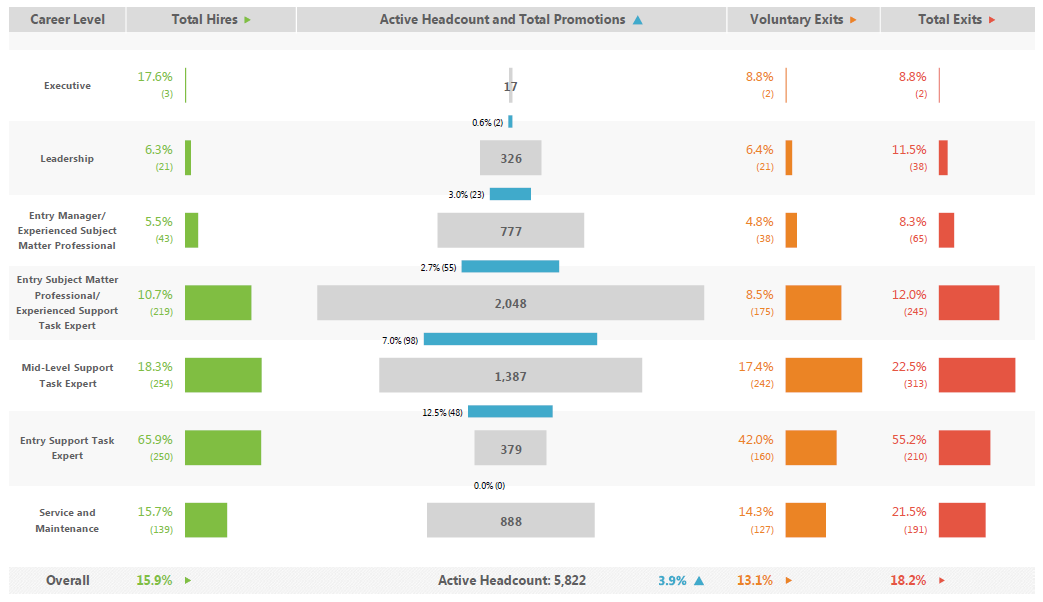
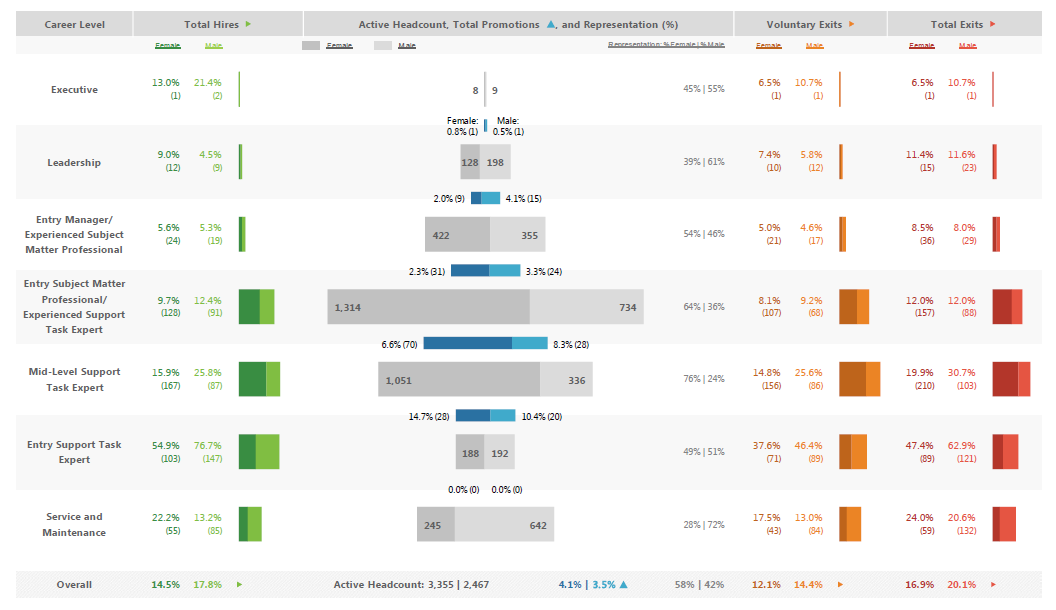
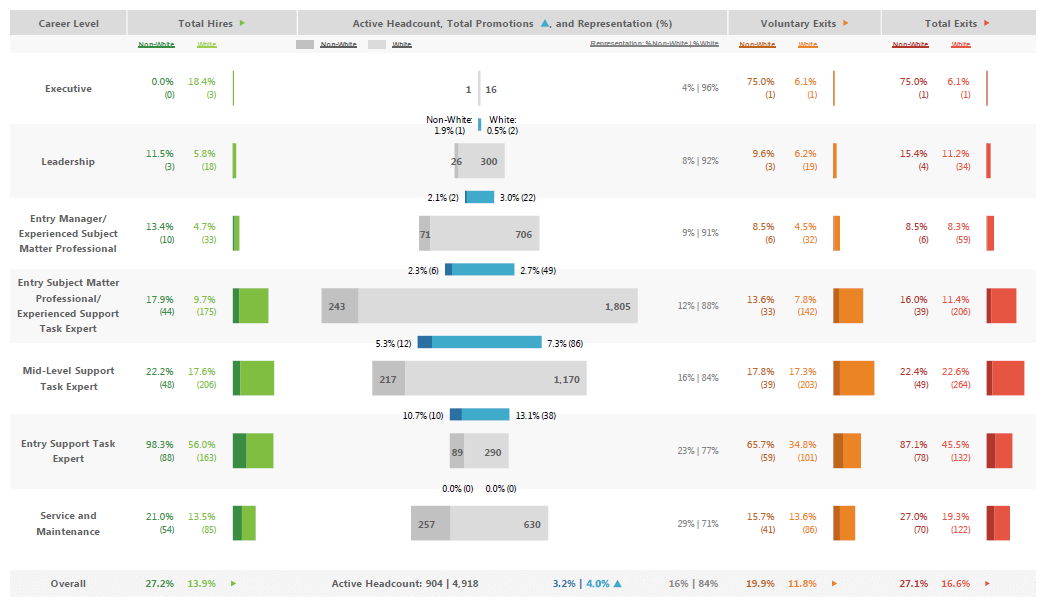
Appendix 2 — Task Force for Recruitment, Retention, Professional Development and Collegial Experience for Underrepresented Minority Faculty (proposed)
This task force would be charged with answering the following question:
How is the recruitment, retention, professional development, and lived experiences of underrepresented minority faculty at The University of Alabama impacted by race?
What follows is a list of additional recommendations concerning the task force:
- The task force chair or co-chairs be provided with a course release.
- Task force members should be provided a stipend.
- Every dean and department head/chair should be active participants in this investigation.
- An external advisory group should be formed to assist the task force.
- Employ the methodology used by the M.I.T. Initiative for Faculty Race and Diversity.

Appendix 3 — An Example of Diversity and Inclusion Competencies
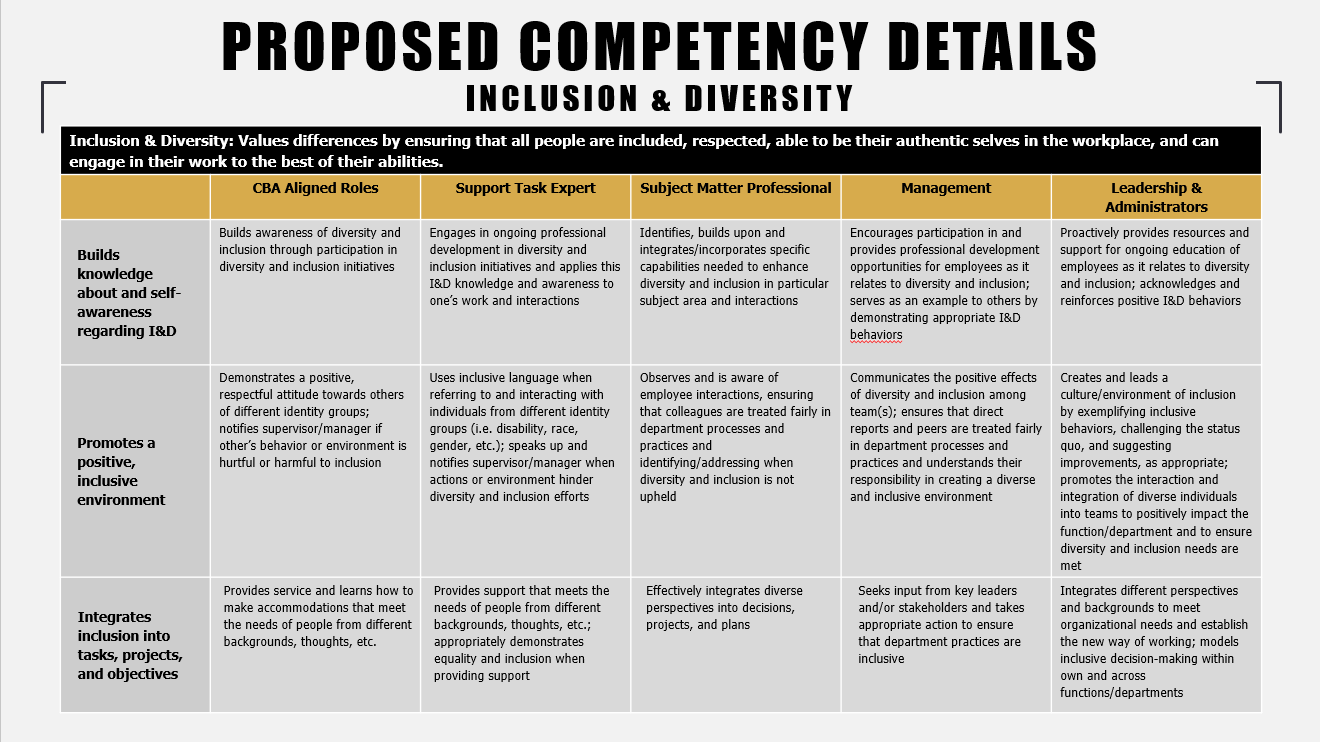
Glossary
Acronyms
AAC&U: Association of American Colleges and Universities. This organization is the standard in higher education for colleges and universities.
DEI: Diversity, Equity and Inclusion
HBCU: Historically Black Colleges and Universities
HSI: Hispanic Serving Institutions
MSI: Minority Serving Institutions
NASNTI: Native American Serving Non-Tribal Institutions
PWI: Predominantly White Institutions
Programs
Academic Common Market: The Academic Common Market is a tuition scholarship program that enables selected students to pursue out-of-state college degrees at discounted tuition rates through agreements among the states, colleges, and universities. The ACM is designed for qualified first-time freshmen, first-time graduate students, and first-time transfer students.
BRIDGE: The BRIDGE experience provides first-year, men of color the opportunity to build a community at The University of Alabama, create a vision and action plan for their legacy at UA, learn about being a UA student, and most importantly, have fun. Participants are led by The BRIDGE Builders, current UA students who will serve as peer facilitators throughout the BRIDGE program. The BRIDGE Builders offer their own story about being a student at UA, give tips for getting involved, and help construct an unforgettable experience for BRIDGE participants.
Lucy’s Legacy: Lucy’s Legacy is a living-learning community for women interested in exploring the historical significance and experiences of women of color at The University of Alabama. This living-learning community is named in honor of Autherine Lucy, the first African American student to attend The University of Alabama. The living-learning community strives to support the academic and social transition of women to The University of Alabama.
McNair Scholars Program: The Ronald E. McNair Post-baccalaureate Achievement Program is a federal TRIO program funded at 151 institutions across the United States and Puerto Rico by the U.S. Department of Education. It is designed to prepare undergraduate students for doctoral studies through involvement in research and other scholarly activities. McNair participants are either first-generation college students with financial need, or members of a group that is traditionally underrepresented in graduate education and have demonstrated strong academic potential. The goal of the McNair Scholars Program is to increase graduate degree awards for students from underrepresented segments of society.
Tide Together: The Tide Together Mentoring Program helps traditionally underrepresented students in graduate programs reach personal and professional success as they navigate the higher education journey. Now in its 12th year, the program accomplishes its goals through a combination of structured workshops and a team of dedicated peer and faculty mentors. Each of the program’s 30 students is carefully chosen in their first or second year and paired with mentors with the aim of supporting the student through to graduation.
UNCF/Mellon: The Mission of the UNCF/Mellon Programs is to Transform the Academy by creating a pipeline of undergraduates who will pursue the PhD with the sole intention of becoming faculty members and leaders within the Academy.
Definitions
Capstone Creed: The Capstone Creed is a statement of principles that guide each student that attends The University of Alabama. Each incoming freshman class pledges to uphold the Capstone Creed during convocation at the start of each academic year.
Exit Interviews/Surveys: Exit interviews/surveys may be a face-to-face conversation, a questionnaire, a survey, or some combination of those methods used to record leaders’ listening skills, reveal what does or doesn’t work inside the organization, highlight hidden challenges and opportunities, and generate essential competitive intelligence. Such interviews can promote engagement and enhance retention by signaling to employees that their views matter.
Inclusive Excellence: Inclusive excellence is the Association of American Colleges and Universities’ guiding principle for access, student success, and high-quality learning designed to help colleges and universities integrate diversity, equity and educational quality efforts into their missions and institutional operations.
Through the vision and practice of inclusive excellence, AAC&U calls for higher education to address diversity, inclusion, and equity as critical to the well-being of democratic culture. Making excellence inclusive is thus an active process through which colleges and universities achieve excellence in learning, teaching, student development, institutional functioning, and engagement in local and global communities.
A high-quality, practical liberal education should be the standard of excellence for all students. The action of making excellence inclusive requires that we uncover inequities in student success, identify effective educational practices, and build such practices organically for sustained institutional change.
Restorative Justice: Restorative justice empowers students to resolve conflicts on their own and in small groups, and it is a growing practice at schools around the country. Essentially, the idea is to bring students together in peer-mediated small groups to talk, ask questions, and air their grievances.